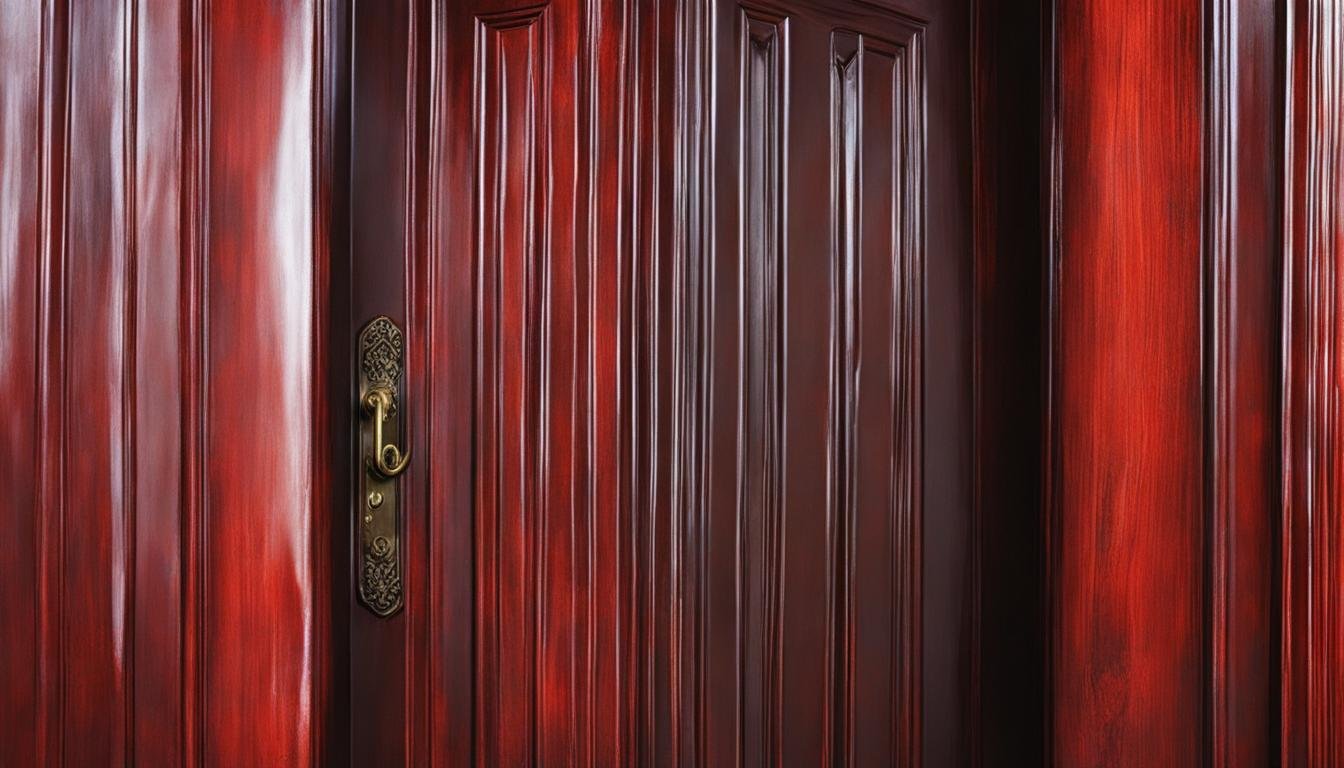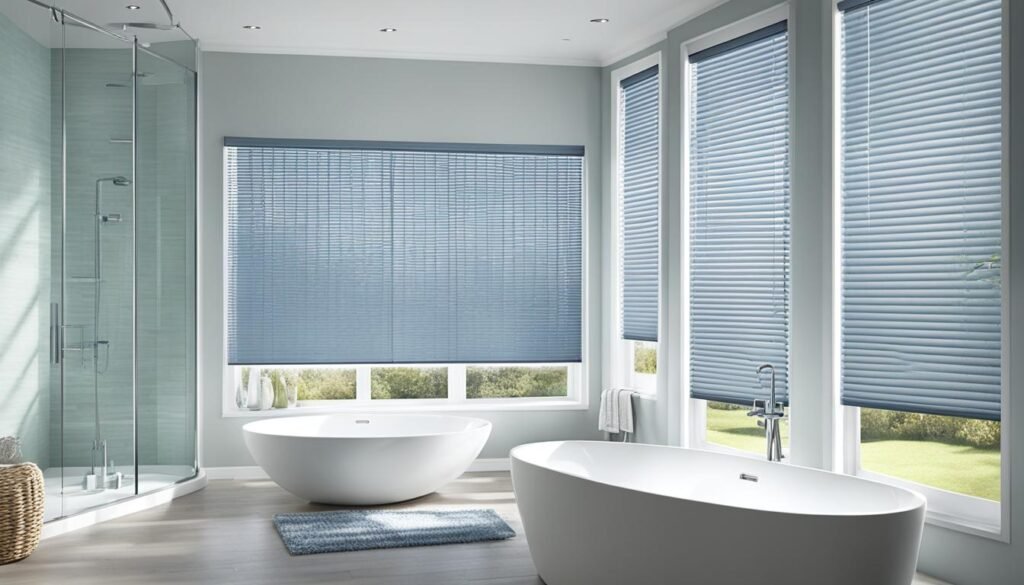When painting your home’s interior, don’t overlook the importance of choosing the right paint for your trims. Interior trims, such as baseboards, crown molding, and door casings, can add a polished and finished look to any room. But with so many options available, how do you know which paint is the best for your interior trims?
Key Takeaways:
- Choosing the right paint for interior trims can enhance a room’s look and feel.
- High-gloss paint offers durability and a reflective surface but may not be suitable for all spaces.
- Semi-gloss paint is popular due to its durability, ease of cleaning, and moderate shine.
- Satin paint provides a subtle sheen and is affordable but may not be as durable as higher gloss paints.
- Eggshell, matte, or flat paints can hide imperfections but are more maintenance-intensive and less resistant to stains and moisture.
This article will explore the top paint options for interior trims, including different finishes and brands. We’ll also discuss the factors you should consider when selecting the perfect paint for your project. Whether you’re looking for a high-gloss finish for detailed trim work or a low VOC option, we’ve got you covered. So, let’s dive in and discover the best paint for your interior trims!
High-Gloss Paint for Trim
- Durability and Moisture Resistance: High-gloss paint provides a durable finish that can withstand wear and tear in high-traffic areas. Its moisture-resistant properties make it suitable for spaces prone to humidity or moisture.
- Reflective Surface: The reflective surface of high-gloss paint adds elegance to your trims, but it may not be suitable for every space due to its highly reflective nature.
- Considerations: High-gloss paint is more expensive than other options and takes longer to dry, leading to imperfections. Proper application is crucial to avoid accentuating brush strokes and minor flaws.
Semi-Gloss Paint for Trim
- Durability and Easy Maintenance: Semi-gloss paint offers a tough, resilient finish that withstands everyday wear and tear. Its smooth surface is easy to clean, making it ideal for areas prone to dirt and stains.
- Moisture Resistance: Semi-gloss paint is moisture-resistant, making it suitable for trims in bathrooms and kitchens where moisture is present.
- Considerations: Skillful application is necessary to avoid visible brush strokes. While slightly more expensive, the durability and performance justify the investment.
Satin Paint for Trim
- Versatility and Affordability: Satin paint provides a subtle sheen that adds elegance to any room. It’s well-suited for low-traffic areas and offers easy application, making it a favorite among DIY enthusiasts.
- Smooth Finish and Water Resistance: Satin paint hides imperfections and brush strokes while being water-resistant and suitable for moisture-prone areas like bathrooms and kitchens.
- Considerations: Satin paint may be less resistant to stains and wear than higher gloss options, requiring gentle cleaning to maintain its appearance.
Eggshell, Matte, or Flat Paint for Trim
- Smooth Application and Aesthetic Appeal: Eggshell, matte, or flat paints can hide flaws and imperfections on trim surfaces, providing a smooth and sophisticated aesthetic.
- Maintenance Challenges: These finishes are not as resistant to stains and dirt, requiring more frequent touch-ups and gentle cleaning to maintain their appearance.
- Moisture Absorption: Eggshell, matte, and flat paints may absorb moisture, leading to mildew buildup if proper ventilation is not maintained.
Consider your specific needs and preferences when selecting the best paint finish for your interior trims, carefully weighing each option’s benefits and drawbacks.
Oil vs. Acrylic-Latex Paint for Trim
- Historical Perspective: Oil-based paints were traditionally favored for their durability and moisture resistance. However, acrylic-latex paints are popular for their smooth finish and easier cleanup.
- Environmental Impact: Acrylic-latex paints have lower VOC emissions, making them more environmentally friendly and safer indoors.
- Drying Time: Oil-based paints have a slower drying time, allowing for better leveling but requiring more patience before handling. Acrylic-latex paints dry faster, making them more convenient for quick projects.
- Application Ease: Acrylic-latex paints are easier to work with, especially for DIY projects, due to their smoother consistency and forgiveness of imperfections. Oil-based paints require more skill for a flawless finish.
Consider these factors when choosing oil-based and acrylic-latex paints for your trim, balancing drying time, application ease, and environmental impact according to your project needs.
Color Considerations for Trim Paint
- Versatility of White Trim: White trim complements various decor styles and lighting conditions while creating a classic and clean look.
- Darker Trim for Depth: Darker trim colors like deep grays or rich browns can add depth and create a contemporary feel, offering a dramatic contrast against lighter walls.
- Matching Wall and Trim Colors: Matching wall and trim paint creates a seamless and cohesive look, enhancing the room’s spaciousness and balance while ensuring trim doesn’t overpower the space.
Ensure you select a non-yellowing paint to maintain the trim’s appearance over time, regardless of the color choice.
Remember that when choosing a color for your trim, consider the overall style and mood you want to achieve in your space. Whether you prefer a traditional, contemporary, or eclectic look, the right trim color can significantly impact the overall ambiance of your room.
Discover the Ideal Paint Brands for Your Trim
Look no further if you’re searching for the perfect paint brand to enhance your interior trim. We’ve curated a list of top-notch recommendations that cater to different finishes, ensuring you find the ideal match for your project.
1. Valspar® Ultra High Gloss Paint & Primer: Elevate with Brilliance
If you desire a high-gloss finish that exudes elegance, Valspar® Ultra High Gloss Paint & Primer is the go-to choice. This top-tier paint guarantees a brilliant finish, adding a sophisticated touch to your trims. Its advanced formula ensures exceptional durability and superior coverage, making it a reliable option for all trim painting needs.
2. Benjamin Moore® ADVANCE Semi-Gloss: Durability Meets Style
For those leaning towards a semi-gloss finish, look no further than Benjamin Moore® ADVANCE Semi-Gloss. Renowned for its top quality, this paint brand boasts exceptional durability, perfecting it for high-traffic areas like baseboards and door casings. Its easy application and low VOC content make it a preferred choice among homeowners, ensuring both style and substance.
3. Wattyl® Aqua Trim Satin: Embrace Satin Sophistication
If a satin finish is your preference, consider Wattyl® Aqua Trim Satin. This popular option provides a smooth and luxurious satin sheen, elevating the look of your trims. Quick drying and low odor properties make it a convenient choice for indoor painting projects, offering style and ease.
Choosing the right paint brand is crucial for achieving a professional and long-lasting result. These recommended brands, each excelling in various finishes, guarantee high-quality paints. Whether you opt for a high-gloss, semi-gloss, or satin finish, these brands deliver exceptional performance and reliability, making them the ideal choice for painting your interior trims.
Tips for Prepping and Painting Trim
To achieve the best finish for your trim, follow these tips for prepping and painting.
1. Clear the area and protect nearby furniture to avoid accidental paint splatters or damage.
2. Sand off imperfections on the trim surface and patch any holes with a suitable filler.
3. Use painter’s tape to achieve neat and clean edges, preventing paint from bleeding onto adjacent surfaces.
4. Before painting, wash the trim surface thoroughly to remove dust, dirt, and grease that may affect adhesion.
5. Consider applying a primer if your trim is bare or you want a more even and durable finish.
6. When painting, apply at least two coats, allowing proper drying time between coats.
7. For the final coat, wait until it is slightly dry before removing the painter’s tape to avoid peeling or smudging.
8. Use proper painting techniques, such as smooth and even brush strokes, or a paint sprayer for a professional finish.
9. If you’re not confident in your painting skills or want a flawless and long-lasting result, consider hiring a professional interior painter.
Remember, proper preparation and technique are significant in achieving the best outcome for your trim painting project.
Oil-Based vs. Acrylic Paint for Interior Doors
When it comes to painting your interior doors, you have the option of choosing between oil-based and acrylic paints. Each type offers unique characteristics, so understanding their benefits can help you make an informed decision.
Oil-Based Paint for Interior Doors
- Thick Consistency: Oil-based paint has a thick consistency, making it ideal for filling imperfections on the door’s surface, especially in high-traffic areas.
- Longer Drying Time: Its longer drying time allows for smoother and more even finishes, providing a durable coating that can withstand wear and tear.
- Strong Odor and Cleanup: However, oil-based paint typically has a strong odor and requires mineral spirits for cleanup, which may not be environmentally friendly.
Acrylic Paint for Interior Doors
- Lower VOC Emissions: Acrylic paint is water-based, resulting in lower volatile organic compound (VOC) emissions than oil-based paint, making it a more environmentally friendly option.
- Faster Drying Time: Acrylic paint dries faster, allowing for quicker project completion, although it may require more coats to achieve a smooth finish.
- Ease of Cleanup: Acrylic paint can be easily cleaned with soap and water, offering convenience in maintenance.
Consider the durability and environmental impact you desire when choosing between oil-based and acrylic paint for your interior doors. Assess your project’s requirements and the condition of your doors to determine the best paint type for your needs. Proper surface preparation and application techniques will ensure a professional-looking finish, regardless of your choice.

The Importance of Paint Finishes for Interior Doors
The choice of finish for your interior doors plays a crucial role in their appearance and durability. Various options, including satin, semi-gloss, glossy, and high-gloss, offer different levels of sheen and practicality.
- Satin Finish: Satin paint provides a subtle sheen, offering an elegant look without excessive reflection. It’s easy to clean and suitable for high-traffic areas.
- Semi-Gloss Finish: Considered an industry standard, semi-gloss paint balances aesthetics and durability. It provides moderate shine and easy maintenance and is ideal for most interior doors.
- Glossy and High-Gloss Finishes: These finishes offer heightened shine, adding glamour to doors. However, they may accentuate imperfections, so they’re best for doors in excellent condition.
When selecting a paint finish for your interior doors, consider your preferred sheen level and the door’s condition. Satin and semi-gloss options are versatile and forgiving, while glossy finishes are best suited for doors in pristine condition.
Choosing the Right Paint for Your Interior Trim and Doors
Selecting the appropriate paint for your interior trim and doors is crucial for achieving a beautiful and durable finish. Consider the paint composition, finish, and color to ensure optimal results.
- Paint Composition: Decide between oil-based and acrylic-latex paints based on durability, ease of cleanup, and environmental impact.
- Finish Options: Choose from high-gloss, semi-gloss, satin, or matte finishes, each offering different levels of shine and durability. Match the finish to your desired aesthetic and the condition of your trim or doors.
- Color Considerations: While white is a classic choice, you can also choose coordinating colors to contrast or complement your room’s theme. Use non-yellowing additives to preserve color integrity, especially in areas exposed to UV rays.
By carefully considering these factors, you can select the right paint for your interior trim and doors, ensuring a lasting and visually appealing finish.
Author
-

Anne Williams is a passionate wordsmith, blending creativity with expertise in SEO to craft captivating content. With a penchant for concise yet compelling prose, she brings stories to life and leaves readers craving more. When she's not penning her next masterpiece, you can find her exploring new coffee shops or lost in the pages of a good book.
View all posts






